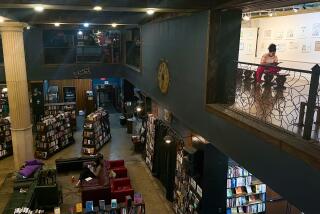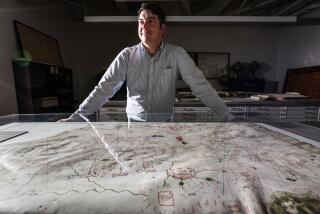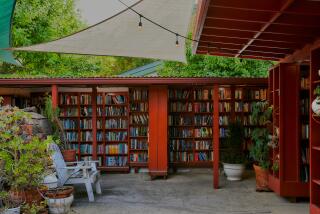Since 1915, Thomas Bros. Has Led in Putting the Golden State on the Map
- Share via
I was there when they put West Pincushion Lane on the Tucson map.
“There” is not in Tucson but at Thomas Bros. Maps in Irvine, the venerable maker of those indispensable street guides that lie tattered on the floor of many Angelenos’ cars. I used to pore over a Thomas Bros. “Los Angeles and Orange Counties Street Guide and Directory” before I moved to L.A.--or even owned a car.
I love maps. Small wonder, then, that my idea of a thrilling field trip is a visit to Thomas Bros., in an office park 3.7 miles southeast of Interstate 5 and California Highway 55. I know this because the mapmaker sent me step-by-step computer-generated directions.
Thomas Bros. displays its wares in a shop at the entrance to the plant. Among the merchandise: detailed street guides to nearly every county in California; some for Oregon, Nevada, Washington state, metropolitan Baltimore and Washington, D.C.; road atlases; large wall maps; and CD-ROM versions of many Thomas Bros. guides, including one that covers all of California and sells for $300.
That may sound pricey, but a Thomas Bros. State of California Digital Edition does more than just help you find your way. Jim Welch, a senior vice president of Rand McNally, the Skokie, Ill., map company that acquired Thomas Bros. in 1999, says the software has been licensed to the California Highway Patrol as a navigational tool. It also has helped firefighters battle wildfires by enabling them to chart the ever-changing boundaries of the blaze and make the information instantly available to colleagues connected via laptop.
The wall-street guides are used to plot deliveries by Pizza Hut, which has a computer system that matches customers’ phone numbers to their addresses and Thomas Bros. map pages.
Welch started my plant tour by showing me a collection of Thomas Bros. maps--a hardbound “executive” edition from 1994, big old Mylar panels with erasure marks that cartographers used before the company went digital about 10 years ago, and a yellowed guide to Oakland, Alameda and Piedmont counties from 1927.
The company was founded in 1915 in Oakland by surveyor George Coupland Thomas and his brothers, Leonard and Gilbert. They made old-fashioned folding maps obsolete by developing page-by-page gridded maps bound in a book. Recognizing that the need for maps was connected to urban growth, the brothers Thomas moved the company to suddenly sprawling L.A. in the early ‘40s and have been in Southern California ever since, making street guides that are accurate within 10 feet, they say.
We are blessed to have them, not only because they keep us from getting lost but also because they are innovators in the mapmaking field. Under the direction of then-company leader Warren Wilson, the company shifted from manual charting to digitalization long before others did. Welch calls Wilson a visionary for starting the process of computerizing data that had been painstakingly collected over the years by ruler, pencil and erasure mapping. Now the company can replicate its geographical data bank in paper, digital systems and wall maps, Welch says.
When Thomas Bros. went digital, it had to renumber its pages and grids. “It’s amazing how many people know the page and grids where they live and work. We turned the world upside-down for a lot of them,” Welch says. “I still have scars from the complaints.” But the result was accurate maps that are flexible enough to change.
When a municipality approves a new subdivision or a fire department notices that the name of a street has changed, they often let Thomas Bros. know, which makes sense because they rely on the guides. Cartographers then confirm the amendments and change the maps. More than 15,000 changes were made for the 2002 edition of the “Los Angeles and Orange Counties Street Guide and Directory,” which has been updated and reissued every year since 1945. Next year there will be more, including new ZIP Codes in Santa Clarita, the renaming of Interstate 10 in West L.A. (now the Rosa Parks Freeway), the addition of malls in Burbank and West Hollywood and interstate and state highway exits that reflect the new numbering project.
My visit to Thomas Bros. also helped me put some misconceptions to rest. Why can’t they make maps with bigger print for aging baby boomers? They can if it’s a map of Portland, Ore., or Tucson. But L.A. is so dense that a large-print version of the Thomas Bros. guide would be phone book size. And do they really put a mistake on each page to detect illegal duplication? Welch says the maps are secretly marked but never misdrawn because emergency services depend on them.
At the end of my visit, I stood over the shoulder of Robert Jones, a young cartographer, as he was putting new geographical information into the Thomas Bros. metropolitan Tucson area map. I saw him add West Pincushion Lane, which didn’t seem all that different from finding a new constellation.
More to Read
Sign up for The Wild
We’ll help you find the best places to hike, bike and run, as well as the perfect silent spots for meditation and yoga.
You may occasionally receive promotional content from the Los Angeles Times.






